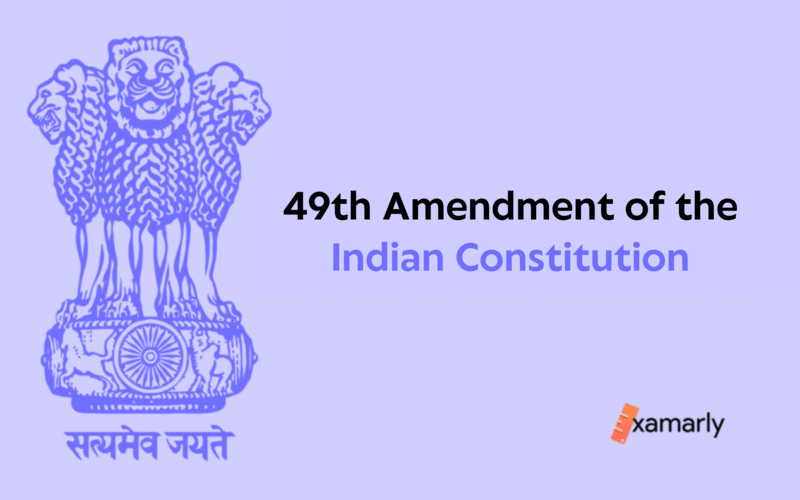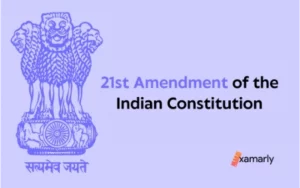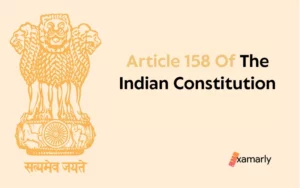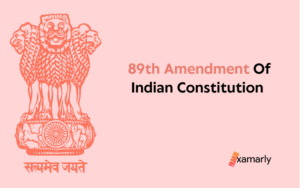The 49th Amendment of the Indian Constitution is officially known as The Constitution (Forty-ninth Amendment) Act, 1984.
The goal of the legislation was to give Tripura’s independent District Council constitutional validity.
This article is about the 49th Amendment of the Indian Constitution which will assist you in your UPSC examination.
49th Amendment of the Indian Constitution
On 11 September 1984, the 49th Amendment came into effect. This amendment modifies article 244 and schedules 5 and 6. When this amendment was approved, Indira Gandhi was the prime minister.
- The 49th Amendment legalised the authority of the Tripura Autonomous District Council.
- The Governor has the authority to change the titles of the autonomous districts. Furthermore, he also has the authority to expand or contract their boundaries.
- The sixth schedule is concerned with managing the tribal lands in the four northeastern states. Meghalaya, Assam, Tripura, and Mizoram are among these states.
- Additionally, it has 10 autonomous district councils spread throughout 4 states.
Object and Reasons
Two resolutions were passed by the Tripura Legislative Assembly requesting that the Sixth Schedule be implemented in the state’s tribal areas (the first on March 19, 1982, and the second on February 11, 1983).
Thus, the Tripura State Government suggested changing the Constitution to achieve its goals. Although an autonomous District Council has been operating in the State under the Tripura Tribal Areas Autonomous District Council Act, 1979, it was deemed necessary to grant it constitutional sanctity.
This was done to meet the aspirations of the tribal population. It is believed that the Council would enable the rapid growth of the tribal territory. Moreover, the tribals’ ability to govern themselves.
The above goals are what the bill aims to do.
See Also – 50th Amendment Of Indian Constitution
Important Provision
The Act shall come into force on such date as the Central Government may, by notification in the Official Gazette, appoint. (Section 1)
The Constitution’s opening paragraph of the Fifth Schedule should read “, Meghalaya, and Tripura,” rather than “and Meghalaya.”
Changes to Article 244. Clauses (1) and (2) of Article 244 of the Constitution should be changed by replacing “and Meghalaya” with “,Meghalaya, and Tripura.” 3.
Source: india.gov.in
Amendment of the Sixth Schedule-In the Constitution’s Sixth Schedule,
(a) The words “and Meghalaya” in the headline shall be replaced with “, Meghalaya and Tripura”;
(b)Parts I, II, and IIA shall be used in place of “Parts I and II” in subparagraph (1) of paragraph I.
(c) The following sentence must be added after paragraph 12A:
Application of Acts of the Legislature of the State of Tripura and the Parliament to the Autonomous District and Autonomous Regions in the State of Tripura (12AA). Regardless of anything in this Constitution,
(a) if any provision of a law made by way of the District or a local Council within the nation of Tripura with respect to any depends laid out in sub-paragraph (1) of paragraph three of this agenda or if any provision of any law made via the District Council or a local Council in that country beneath paragraph eight or paragraph 10 of this agenda, is repugnant to any provision of a law made by the Legislature of the kingdom of Tripura with appreciate to the problem, then, the regulation or law made by means of the District Council or, as the case can be.
The nearby Council whether or not made before or after the law made by way of the Legislature of the nation of Tripura, shall, to the quantity of repugnancy, be void and the law made through the Legislature of the country of Tripura shall be successful;
(b)The President has the authority to indicate through a notification whether a certain Act of Parliament is to apply or not apply to an autonomous district or area in the State of Tripura, as well as any modifications or exceptions that may be made. Additionally, any such direction may be given so as to have a retrospective effect.”
(c) In paragraph 17, at both locations where the phrase “or Meghalaya” appears, the phrase “or Tripura” shall be inserted;
(d) In paragraph 20,-
(i) in sub-paragraph (1),-
(A) The figures and letter “, IIA” must be added after the words and figures “in Parts I, II”;
(B)The phrase “, the State of Tripura” shall be placed after the phrase “the State of Meghalaya”;
(ii) Any reference in Part I, Part II, or Part III of the table below shall be replaced with “Any reference in the table below” in Subparagraph (2).
(iii) The following sub-paragraph shall be introduced after paragraph (2), namely:-
(3) The term “Tripura Tribal Territories District” used in Part IIA of the table below should be understood to refer to the area including the tribal areas listed in the First Schedule of the Tripura Tribal Areas Autonomous District Council Act, 1979.
(e) After Part II and the entries related to it, the following Part must be entered in the Table, specifically:-
“PART IIA Tripura Tribal Areas District.”
Conclusion
The 49th Amendment went into effect on 11 September 1984. With this constitutional amendment, Tripura will be recognized as a tribal state. Additionally, permit the establishment of a Tripura Tribal Areas Autonomous District Council.
FAQs
Which Autonomous District Council Receives Constitutional Sanctity By The 49th Amendment Of The Indian Constitution?
In accordance with the 49th Amendment to the Indian Constitution, the Tripura Autonomous District Council was granted constitutional validity.
Where is Tripura located?
Tripura is a state located in northeastern India, bordered by Bangladesh to the north, south, and west, and the Indian states of Assam and Mizoram to the east.
What are the official languages of Tripura?
The official languages of Tripura are Bengali and Kokborok. English and Hindi are also widely spoken.
What is the main source of income in Tripura?
Agriculture and allied activities are the main sources of income in Tripura. Other industries such as handicrafts, bamboo products, and tourism also contribute to the economy.
What are some tourist attractions in Tripura?
Some popular tourist attractions in Tripura include the Ujjayanta Palace, Neermahal Palace, Sepahijala Wildlife Sanctuary, Unakoti rock-cut carvings, and the Jampui Hills.






